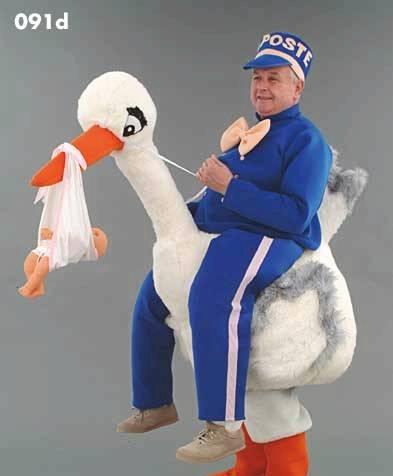Were-Storks and the Origins of Storks’ Baby Carrying! October 26, 2013
Author: Beach Combing | in : Medieval , trackbackThere is the well established legends of the storks flying, in antiquity down below the Sahara to battle the pygmies. But what about this unusual medieval legend that appears in a fourteenth-century work in two parts. First our author is describing the well-established error, one that survived into the nineteenth century, that certain birds hibernate in water.
Similarly they say that storks are human beings in remote parts of the world, and live among us in the semblance of birds. What I judge remarkable in their regard is that in winter they immerse themselves in rivers, and sleep on the river-bed; sometimes they are dragged up from there by fishermen. And we have seen them, when they have been hauled out of deep water in such a way, grow warm by a fire as it they were being roused from a heavy sleep, and come back to life, although before they seemed as insensible as stones. So, too, swallows pass the winter asleep, clinging to hollow oaks.
Sic ciconias asserunt in remotis orbis partibus hominess esse, et apud nos in auium specie uiuere. De quibus mirandum iudico quod in hyeme fluminbus se immergunt, in quorum fundo nonnumquam a piscatoribus dormientes extrahuntur. Nosque taliter e gurgite tractas uidimus ad ignem calfieri uelut a graui sompno expergefactas, et uite reddi, cum antea more lapidum insensibiles uiserentur. Sic et yrundines quercubus infixe concauis dormiendo yemem transigunt.
We have there, unfortunately, just a throwaway comment on the storks. But later our author returns to the theme while discussing, apparently Ethiopia: his geography is unclear. The unusual giants who live there head north to have their kids: medieval welfare scroungers?
In these midst of these routes there is a settlement rendered fertile by the irrigation of the Nile. For the Nile swells the Briso, a river of Egypt, and the land, flooded by the beneficial action of this river, is reclaimed to fertility. In this basin of the river Briso elephants are found in great numbers. There are also human beings with thighs as much as twelve feet long, the rest of whose body does not exceed the same length of twelve feet. Their arms are white up to the shoulders, their calves are black, their feet red, their head round, and their nose long. These people turn into storks in certain seasons, and every year they produce their young in our midst.
Inter has autem uias colonia est ex irrigation Nili fertilis facta. Nilus enim implet Brisonem, Egypti fluuium, cuius beneficio terra inundata ad fertilitatam reuocatur. In his Brisonis fluuii confiniis elefantes nascuntur affluenter; hominess quoque longa femora ad mensuram duodecim pedum habentes: reliquum corpus itidem duodecim pedum longitudine terminator. Horum brachia candida usque ad humeros, sure nigre, pedes rubei, capud rotundum, nasus procerus. Hii hominess certis temporibus in ciconias transformantur, et apud nos quotannis fetum faciunt.
Might this be the origin of the stork-carrying-the-baby legend: drbeachcombing AT yahoo DOT com



